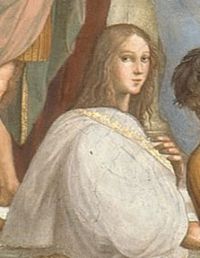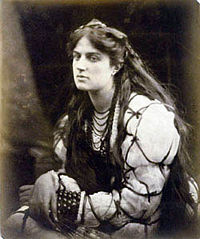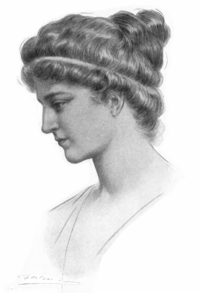Hypatia of Alexandria
| Hypatia Ancient philosophy |
|
 Hypatia as imagined by Raphael |
|
| Full name | Hypatia (Υπατία) |
|---|---|
| Birth | c. 370 |
| Death | 415 |
| School/tradition | Platonism |
| Main interests | Mathematics, astronomy |
|
Influenced by
|
|
|
Influenced
|
|
Hypatia of Alexandria (pronounced /haɪˈpeɪʃə/) (Greek: Ὑπατία; born between AD 350 and 370 – 415) was a Greek[1][2] scholar from Alexandria in Egypt,[3][4] considered the first notable woman in mathematics, who also taught philosophy and astronomy.[5] She lived in Roman Egypt, and was killed by a Coptic Christian mob who blamed her for religious turmoil. She has been hailed as a "valiant defender of science against religion",[6] and some suggest that her murder marked the end of the Hellenistic Age.[7][8]
A Neoplatonist philosopher, she followed the school characterized by the 3rd century thinker Plotinus, and discouraged mysticism while encouraging logical and mathematical studies.[9]
Contents |
Life
Hypatia was the daughter of Theon, who was her teacher and the last known mathematician associated with the museum of Alexandria.[10] She traveled to both Athens and Italy to study,[11] before becoming head of the Platonist school at Alexandria in approximately AD 400.[12] According to the Byzantine "Suda", she worked as teacher of philosophy, teaching the works of Plato and Aristotle.[13] It is believed that there were both Christians[14] and foreigners[9] among her students.
Although Hypatia was herself a Pagan, she was respected by a number of Christians, and later held up by Christian authors as a symbol of virtue.[9] The Suda controversially[15] declared her "the wife of Isidore the Philosopher"[13] but agreed she had remained a virgin.[16]
Hypatia rebuffed a suitor by showing him her menstrual rags, claiming they demonstrated that there was "nothing beautiful" about carnal desires.[13]
Hypatia maintained correspondence with her former pupil Bishop of Ptolomais Synesius of Cyrene.[17] Together with the references by Damascius, these are the only writings with descriptions or information from her pupils that survive.[18]
The contemporary Christian historiographer Socrates Scholasticus described her in his Ecclesiastical History:
There was a woman at Alexandria named Hypatia, daughter of the philosopher Theon, who made such attainments in literature and science, as to far surpass all the philosophers of her own time. Having succeeded to the school of Plato and Plotinus, she explained the principles of philosophy to her auditors, many of whom came from a distance to receive her instructions. On account of the self-possession and ease of manner, which she had acquired in consequence of the cultivation of her mind, she not unfrequently appeared in public in presence of the magistrates. Neither did she feel abashed in going to an assembly of men. For all men on account of her extraordinary dignity and virtue admired her the more.[9]
Works

Many of the works commonly attributed to Hypatia are believed to have been collaborative works with her father, Theon Alexandricus.
A partial list of specific accomplishments:
- A commentary on the 13-volume Arithmetica by Diophantus[19]
- Edited the third book of her father's commentary on Ptolemy's Almagest[20]
- Edited her father's commentary on Euclid's Elements[21]
- Edited a commentary that simplified Apollonius's Conics[22]
- She wrote the text The Astronomical Canon[23]
Her contributions to science are reputed to include the charting of celestial bodies[5] and the invention of the hydrometer,[24] used to determine the relative density and gravity of liquids.
Her pupil Synesius wrote a letter defending her as the inventor of the astrolabe, although earlier astrolabes predate Hypatia's model by at least a century - and her father had gained fame for his treatise on the subject.[22]
Death
Believed to have been the reason for the strained relationship between the Imperial Prefect Orestes and the Bishop Cyril, Hypatia attracted the ire of a Christian population eager to see the two reconciled.
One day in March 415,[25] during the season of Lent, her chariot was waylaid on her route home by a Christian mob, possibly Nitrian monks[25] led by a man identified only as "Peter".
She was stripped naked and dragged through the streets to the newly christianised Caesareum church and killed. Some reports suggest she was flayed with ostrakois (literally, "oyster shells", though also used to refer to roof tiles or broken pottery) and set ablaze while still alive, though other accounts suggest those actions happened after her death:
| Socrates Scholasticus (5th-century) | John of Nikiû (7th-century) | Edward Gibbon (18th-century) | ||
|---|---|---|---|---|
|
Yet even she fell a victim to the political jealousy which at that time prevailed. For as she had frequent interviews with Orestes, it was calumniously reported among the Christian populace, that it was she who prevented Orestes from being reconciled to the bishop. Some of them therefore, hurried away by a fierce and bigoted zeal, whose ringleader was a reader named Peter, waylaid her returning home, and dragging her from her carriage, they took her to the church called Caesareum, where they completely stripped her, and then murdered her by scraping her skin off with tiles and bits of shell. After tearing her body in pieces, they took her mangled limbs to a place called Cinaron, and there burnt them. |
And in those days there appeared in Alexandria a female philosopher, a pagan named Hypatia, and she was devoted at all times to magic, astrolabes and instruments of music, and she beguiled many people through Satanic wiles...A multitude of believers in God arose under the guidance of Peter the magistrate...and they proceeded to seek for the pagan woman who had beguiled the people of the city and the prefect through her enchantments. And when they learnt the place where she was, they proceeded to her and found her...they dragged her along till they brought her to the great church, named Caesarion. Now this was in the days of the fast. And they tore off her clothing and dragged her...through the streets of the city till she died. And they carried her to a place named Cinaron, and they burned her body with fire. |
A rumor was spread among the Christians, that the daughter of Theon was the only obstacle to the reconciliation of the prefect and the archbishop; and that obstacle was speedily removed. On a fatal day, in the holy season of Lent, Hypatia was torn from her chariot, stripped naked, dragged to the church, and inhumanly butchered by the hands of Peter the Reader and a troop of savage and merciless fanatics: her flesh was scraped from her bones with sharp oyster-shells and her quivering limbs were delivered to the flames. |
Despite her actual background, authors Soldan and Heppe wrote a text in 1990 arguing that Hypatia may have been the first famous "witch" punished under Christian authority.[26]
Legacy


Shortly after her death, a forged letter attacking Christianity was published under her name.[27] The pagan historian Damascius, "anxious to exploit the scandal of Hypatia's death",[23] laid the blame squarely on the Christians and Bishop Cyril.
In the 14th century, historian Nicephorus Gregoras described Eudokia Makrembolitissa as a "second Hypatia".[18]
In the early 18th century, the deist scholar John Toland used her death as the basis for an anti-Catholic tract entitled "Hypatia: Or the history of a most beautiful, most vertuous, most learned, and every way accomplish’d lady; who was torn to pieces by the clergy of Alexandria, to gratify the pride, emulation, and cruelty of their archbishop, commonly but undeservedly stil’d St. Cyril.[28] This led to a counter-claim being published by Thomas Lewis in 1721 entitled The History Of Hypatia, A most Impudent School-Mistress of Alexandria.[29]
Eventually, her story began to be infused with Christian details, as her story was first substituted for the missing history of Saint Catherine of Alexandria.[30][31]
In the nineteenth century, interest in the "literary legend of Hypatia" began to peak.[18]
Diodata Saluzzo Roero's 1827 Ipazia ovvero delle Filosofie suggested that Cyril had actually converted Hypatia to Christianity, and that she had been killed by a "treacherous" priest.
In his 1847 Hypatie and 1857 Hypatie et Cyrille, French poet Charles-Marie-René Leconte de Lisle portrayed Hypatia as the epitome of "vulnerable truth and beauty".[32]
Charles Kingsley's 1853 fictionalized novel Hypatia - or New Foes with an Old Face, which portrayed the scholar as a "helpless, pretentious, and erotic heroine",[33] recounted her conversion by a Jewish-Christian named Raphael Aben-Ezra after supposedly becoming disillusioned with Orestes.
In 1868, Julia Margaret Cameron produced a photographic depiction of the ancient scholar Hypatia.[34]
The lunar crater Hypatia was named after the philosopher, in addition to craters named for Cyril and her father Theon. Measuring 28x41 kilometres, the crater is located 4.3°S and 22.6°E of the meridian. The 180km Rimae Hypatia, is located north of the crater, one degree south of the equater, along the Mare Tranquillitatis.[35]
Marcel Proust reference Hypatia in the last sentence of "Madame Swann at Home," the first section of Within a Budding Grove.
Later references
- Feminist artist Judy Chicago included Hypatia in the First Wing of her work The Dinner Party.
- The Heirs of Alexandria series written by Mercedes Lackey, Eric Flint and Dave Freer, includes fictitious references to Hypatia's conversion to Christianity and subsequent correspondence with John Chrysostom and Augustine.
- Hypatia Cade, a precocious child and main character in the science fiction novel The Ship Who Searched by Mercedes Lackey and Anne McCaffrey is named after Hypatia of Alexandria.
- Umberto Eco's novel Baudolino sees the protagonist meet a secluded society of satyr-like creatures who all take their name and philosophy from Hypatia.
- Rinne Groff's 2000 play The Five Hysterical Girls Theorem features a character named Hypatia who lives silently, in fear that she will suffer the fate of her namesake.
- Remembering Hypatia is a fictional treatment of her life and death by author Brian Trent.[36]
- Hypatia is a recurring character in Mark London Williams' juvenile fiction Danger Boy
- Hypatia is the name of a 'shipmind' (ship computer), modeled after the historical Hypatia, in The Boy Who Would Live Forever, a novel in Frederick Pohl's Heechee series.
- Hypatia Sans Pro is an Adobe typeface named after her.[37]
- The Corto Maltese adventure Fable of Venice, by characteristic superposition of anachronistic elements, sees Hypatia preside over an intellectual salon in pre-Fascist Italy.
- Carl Sagan, in Cosmos: A Personal Voyage, discussed Hypatia and gave a detailed description, though speculative, of her death and the destruction of the Library of Alexandria. He declares her, without corroboration, its last librarian and links its destruction with her death.
- Hypatia: A Journal of Feminist Philosophy has been published since 1986 by Indiana University Press.
- Hypatia is also the name of a Madison, WI-based cooperative community house, one of 13 Madison Cooperative Community (MCC) houses in the area.
- Novelist Ki Longfellow is at work on a novel of Hypatia's life, tentatively titled Flow Down Like Silver, with a tentative publication date of 2009.
- Ágora, a film in production in 2008, written and directed by Alejandro Amenábar, is about a slave of Hypatia who falls in love with her. Hypatia is portrayed by Rachel Weisz; the film is expected to be released in 2009.
- Egyptian author Dr. Yūsuf Zaydān wrote the novel ‘Azazīl’ that tells the story of an Egyptian monk living during a time period when Christians used to tyrannize pagans and demolish their temples. The circumstances leading to the death of Hypatia is a major part of this book. The author wants to underline with his book the importance of freedom of belief. [38]
References
- ↑ Mueller, I.; L.S. Grinstein & P.J. Campbell (1987). Women of Mathematics: A Biobibliographic Sourcebook. New York: Greenwood Press.
- ↑ 1. Groundbreaking Scientific Experiments, Inventions, and Discoveries, Krebs. 2. The Woman Citizen By Horace Adelbert Hollister.3. Russian Women's Studies: Essays on Sexism in Soviet Culture 4.Available Means: An Anthology of Women's Rhetoric
- ↑ Hypatia, Encyclopædia Britannica: "Egyptian Neoplatonist philosopher who was the first notable woman in mathematics."
- ↑ Columbia Encyclopedia, Hypatiacitation:Alexandrian Neoplatonic philosopher and mathematician
- ↑ 5.0 5.1 Toohey, Sue (2003). "The Important Life & Tragic Death of Hypatia". Skyscript.co.uk. Retrieved on 2007-12-09.
- ↑ John William Draper, as quoted in the 1996 The Literary Legend of Hypatia by Maria Dzielska
- ↑ Women Philosophers in the Ancient Greek World: Donning the Mantle, by Kathleen Wider. Hypatia © 1986 Indiana University Press p. 49-50
- ↑ Mangasarian, Mangasar Mugurditch. The Martyrdom of Hypatia, 1915
- ↑ 9.0 9.1 9.2 9.3 Scholasticus, Socrates. Ecclesiastical History.
- ↑ Michael Deakin (August 3, 1997). "Ockham's Razor: Hypatia of Alexandria". ABC Radio. Retrieved on 2008-05-23.
- ↑ Multicultural Resource Center: Hypatia
- ↑ Historical Dictionary of Feminism, by Janet K. Boles, Diane Long Hoeveler. pp 166.
- ↑ 13.0 13.1 13.2 Suda online, Upsilon 166
- ↑ Bregman, J. (1982). "Synesius of Cyrene: Philosopher-bishop". Berkley: University of California Press.
- ↑ Kingsley, Charles. "Hypatia", preface, quoting and agreeing with Gibbon
- ↑ Great Inspirations - Hypatia
- ↑ A. Fitzgerald, Letters of Synesius of Cyrene, London, 1926. (Letter 154 of Synesius of Cyrene to Hypatia).
- ↑ 18.0 18.1 18.2 Dzielska, Maria. Hypatia of Alexandria. Oxford Press, 1996.
- ↑ The Life and Legacy of Hypatia
- ↑ Hypatia of Alexandria
- ↑ Grout, James. Encyclopædia Romana
- ↑ 22.0 22.1 Chris Marvin, Frank Sikernitsky The Window:Philosophy on the Web
- ↑ 23.0 23.1 Whitfield, Bryan J. The Beauty of Reasoning: A Reexamination of Hypatia of Alexandra
- ↑ Ethlie Ann Vare and Greg Ptacek, Mothers of Invention 1988, pp. 24-26.
- ↑ 25.0 25.1 O'Connor, John J.; Robertson, Edmund F., "Hypatia of Alexandria", MacTutor History of Mathematics archive
- ↑ Soldan, W.G. und Heppe, H., Geschichte der Hexenprozesse, Essen 1990. p.82.
- ↑ Synodicon, c. 216, in iv. tom. Concil. p. 484, as detailed in The History of the Decline and Fall of the Roman Empire, vol. 8, chapter XLVII
- ↑ Ogilvie, M. B. (1986). Women in science: Antiquity through the nineteenth century. Cambridge, MA: The MIT Press.
- ↑ The History Of Hypatia, A most Impudent School-Mistress of Alexandria: Murder'd and torn to Pieces by the Populace, In Defence of Saint Cyril and the Alexandrian Clergy. From the Aspersions of Mr. Toland.
- ↑ This article incorporates text from the entry St. Catherine of Alexandria in the public-domain Catholic Encyclopedia of 1913.
- ↑ Jameson, Anna. "Sacred and Legendary Art", 1857. pp 84.
- ↑ Edwards, Catharine. "Roman Presences: Receptions of Rome in European Culture, 1789-1945" pp. 112
- ↑ Snyder, J.M. (1989). The woman and the lyre: Women writers in classical Greece and Rome.. Carbondale, IL: Southern Illinois University Press.
- ↑ Marsh, Jan; Pamela Gerrish Nunn (1998). Pre-Raphaelite Women Artists. London: Thames & Hudson.
- ↑ "Hypatia of Alexandria: A woman before her time". The Woman Astronomer (November 11,2007). Retrieved on 2007-12-03.
- ↑ "Remembering Hypatia: A Novel of Ancient Egypt".
- ↑ "Hypatia Sans Pro, my new typeface". Adobe Systems. Retrieved on 2008-08-24.
- ↑ Rose al-Yusuf, May 9, 2008 reviewed by Arab-West Report, 2008, week 18, art. 48
External links
- "Hypatia", Biographies of Women Mathematicians, Agnes Scott College
- Resources on Hypatia: booklist, classroom activities
- Hypatia on ABC Radio Transcript of an interview with Dr Michael Deakin about his research on Hypatia, broadcast on Australia's ABC Radio National. Sunday, 3 August, 1997
- Hypatia of Alexandria: Defender of Reason Hypatia's impact on the course of human history.
- A collection of free high-resolution Hypatia-related images.
- Women in Science
|
|||||||||||||||||||
|
|||||||||||||||||||||||